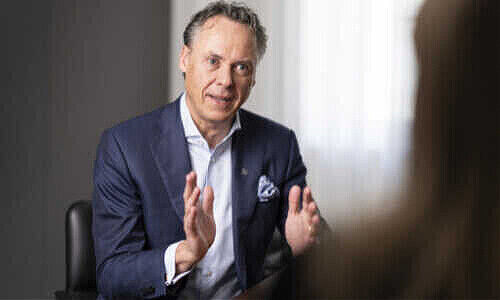UBS faces far less pressure to change strategy than Credit Suisse does. But CEO Ralph Hamers may still want to draw some lines in the sand next week.
UBS will be setting new targets for the first time in four years next week. It will also be 15 months into UBS CEO Ralph Hamers tenure, and an apt time for a more comprehensive update.
In contrast to direct competitor Credit Suisse, UBS hasn't held an investor day since 2018 and it isn't planning on one. It will simply disclose more specifics on its strategy when releasing fourth quarter 2021 earnings. But this time, we can reasonably expect a larger roll of the die than last, when Hamers seemed to tiptoe gently around that very subject.
Buoyant Markets
Although that was disappointing for some observers then, it worked in hindsight. It was probably more than worth it that the Netherlander, known as a hard-hitting digitalization advocate, did not try to change everything at the outset. It likely allowed the core wealth management business under Co-Heads Iqbal Khan und Tom Naratil to benefit from the buoyant markets and environment during the pandemic.
That has paid off for shareholders. Since he started, UBS shares are up almost 60 percent.
Over the past few months, Hamer has been working to change the UBS culture. All employees need to have a «Purpose». UBS's traditional hierarchical structures now face up against Agile Working practices and about 9,000 employees will be working under that model shortly. In the information technology area, he wants to build a «culture of engineers».
Putting the Bank on an App
Hamers appointed Mike Dargan as Chief Digital and Information Officer (CDIO) to watch over everything. He is not only responsible for IT and digitalization but the entire back office. Hamers announced it last autumn: «There is so much more than we can do».
The acquisition of robo adviser Wealthfront for $1.4 billion dollars, announced last Wednesday, shows the direction that UBS is taking. Hamers wants to put the bank on an app, as he announced he would do for the Swiss business and having better, deeper digital services will allow it to attract a younger, affluent clientele.
No More Messing Around
The focus will be on the US and Asia, where a banking app in China waits in the wings for official approval. The Wealthfront deal also shows that the bank isn't messing around anymore. Businesses that are too small or not profitable enough are being discarded, such as the US offshore client business booked in Switzerland, or the sale of operations in Austria and Spain.
Hamers spoke clearly about it last spring. «UBS will concentrate Global Wealth Management on large businesses and market regions, the Americas, Asia, Europe and Switzerland.» That is also a good indicator that other exits will follow.
Higher Dividends
For investors, Hamers is likely to put the onus on stability. Financial analysts expect a «progressive» attitude when it comes to returning capital to shareholders, whether through dividends or further buybacks. This should be above and beyond last year's $4.5 billion program. When asked, a UBS spokesperson did not comment on it.
The bank is, of course, not entirely free of all risk. Hamers largest risk is actually a very personal one. The Netherlands is still involved in an investigation over whether his former employer, ING, helped clients evade taxes or not. Should he be eventually convicted as the former ING CEO and one of those responsible, his function at UBS would be in danger.
New Targets?
There is also some unclarity about the large tax evasion case in France, which has been running for eight years. Even though UBS's fine was cut after its original appeal, it has decided to ask a retrial of the most recent decision given the judges in Paris had deemed UBS punishable.
UBS will not be releasing divisional targets next week although it is widely expected to update group targets.
Additional reporting: Katharina Bart und Samuel Gerber



































